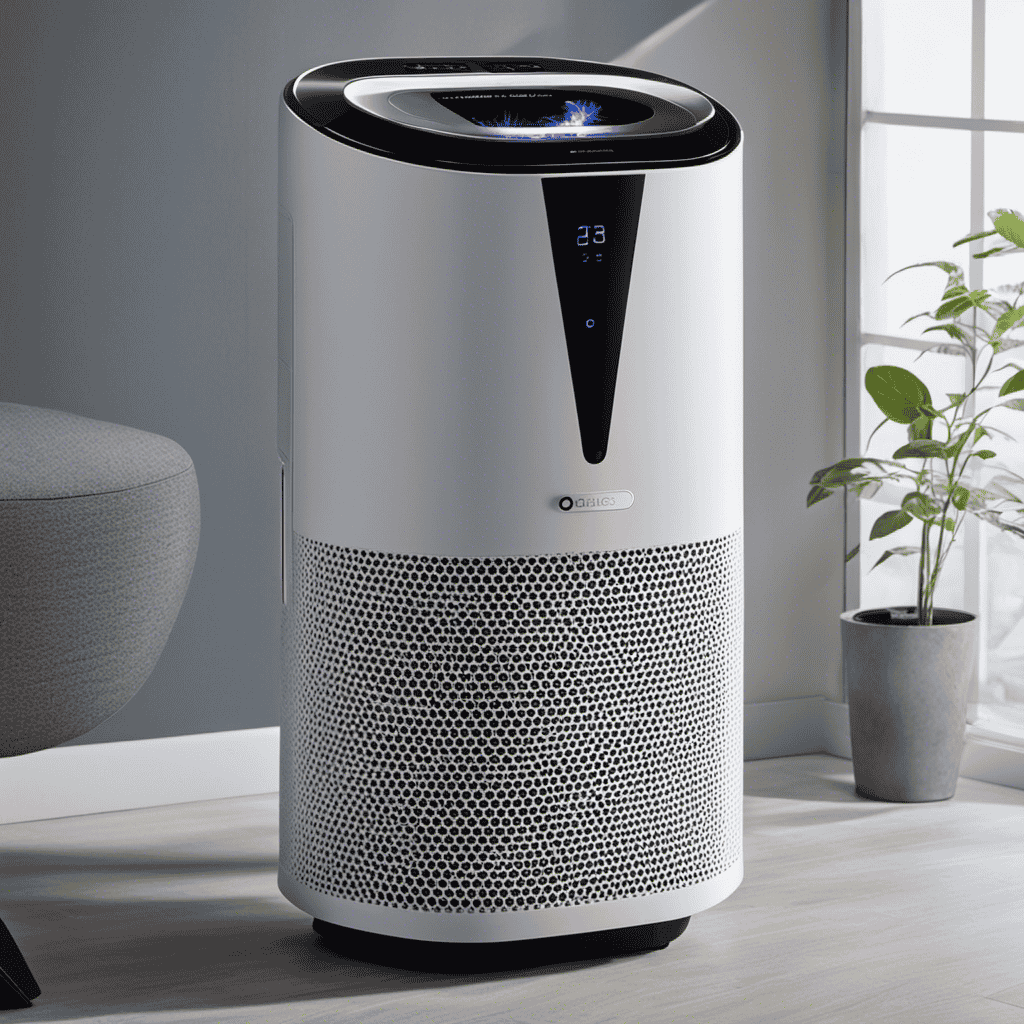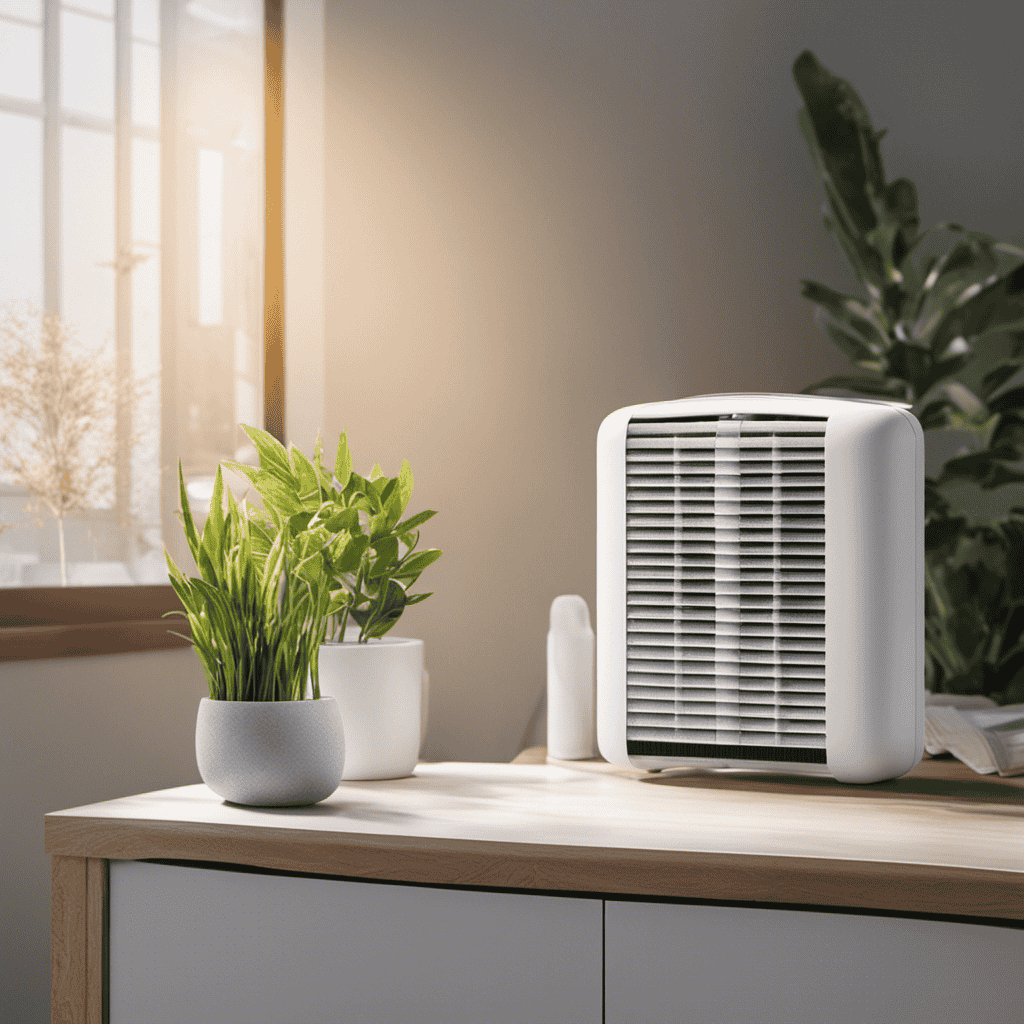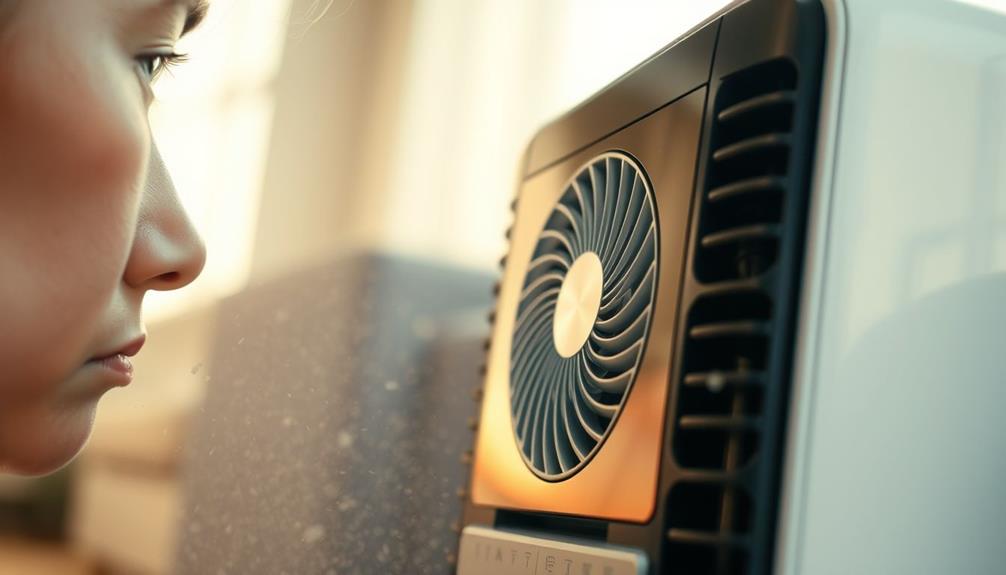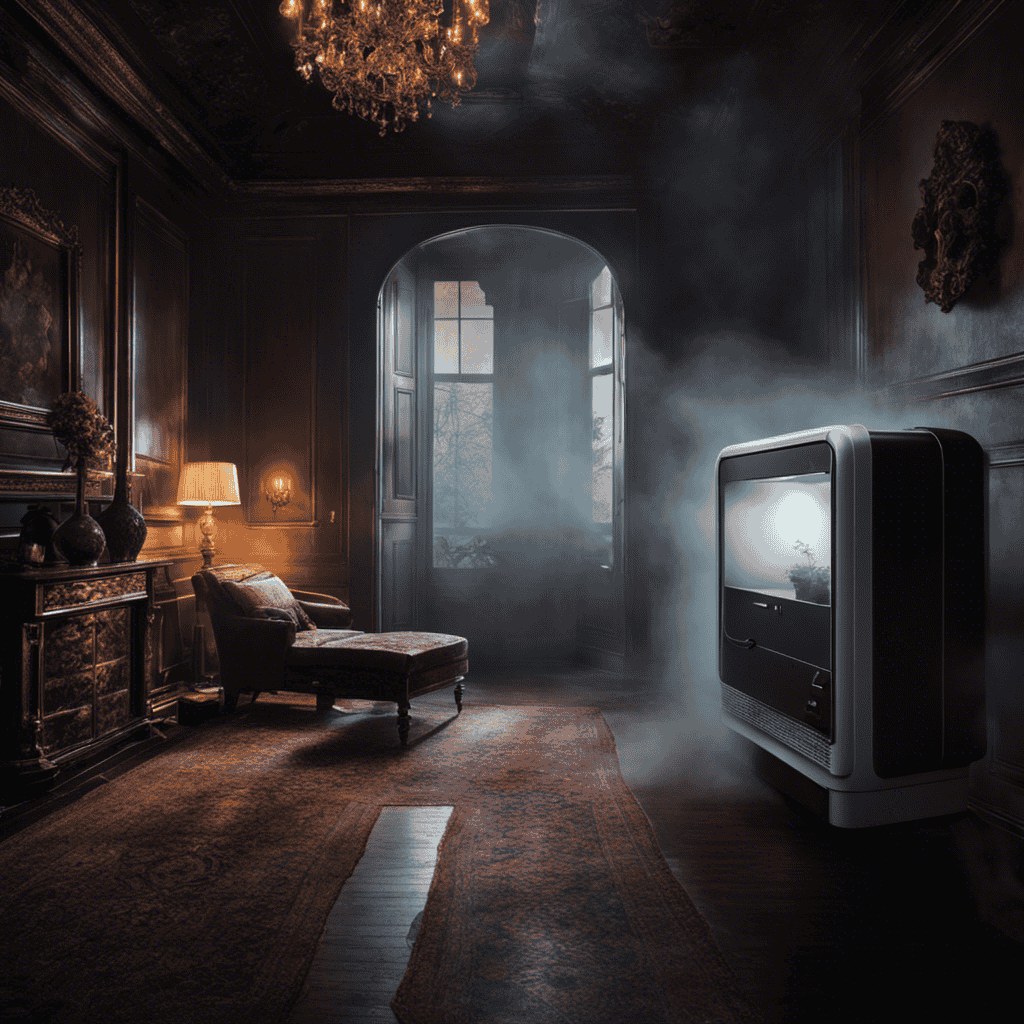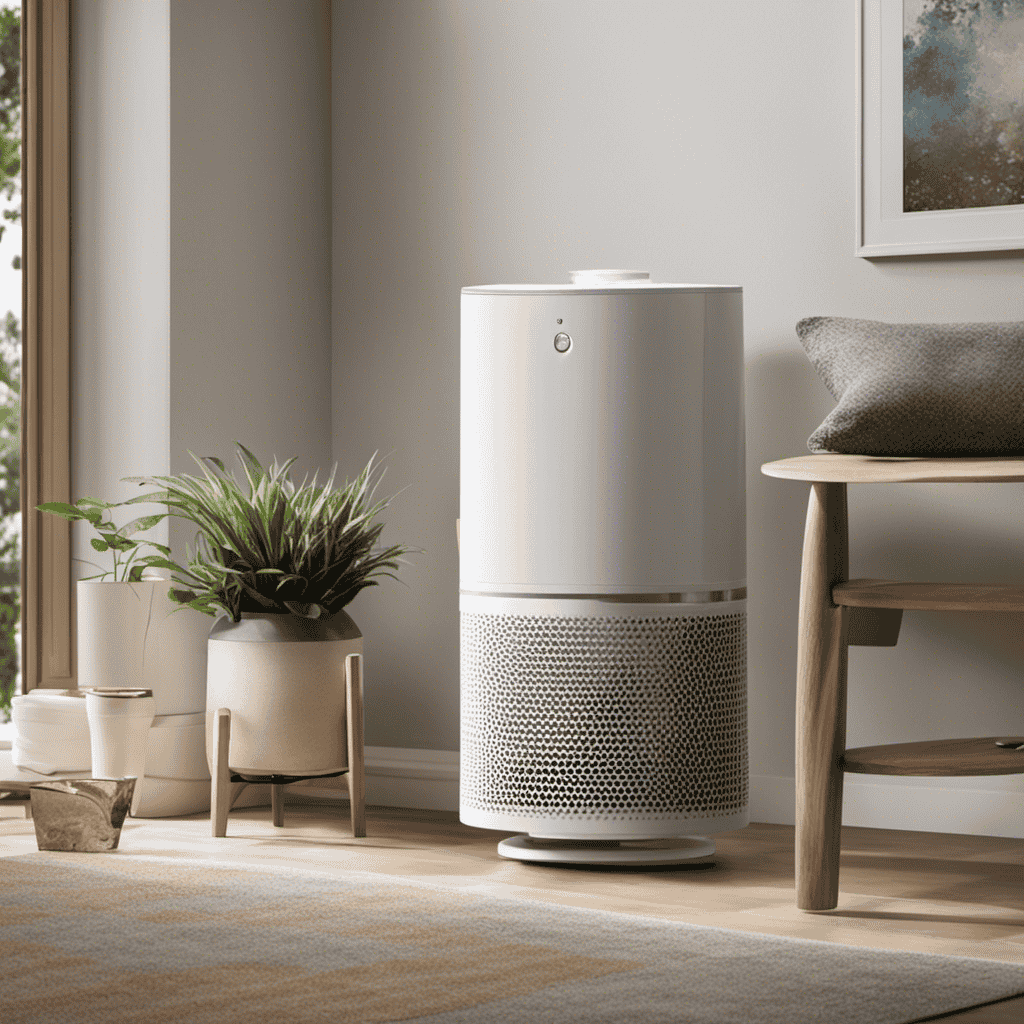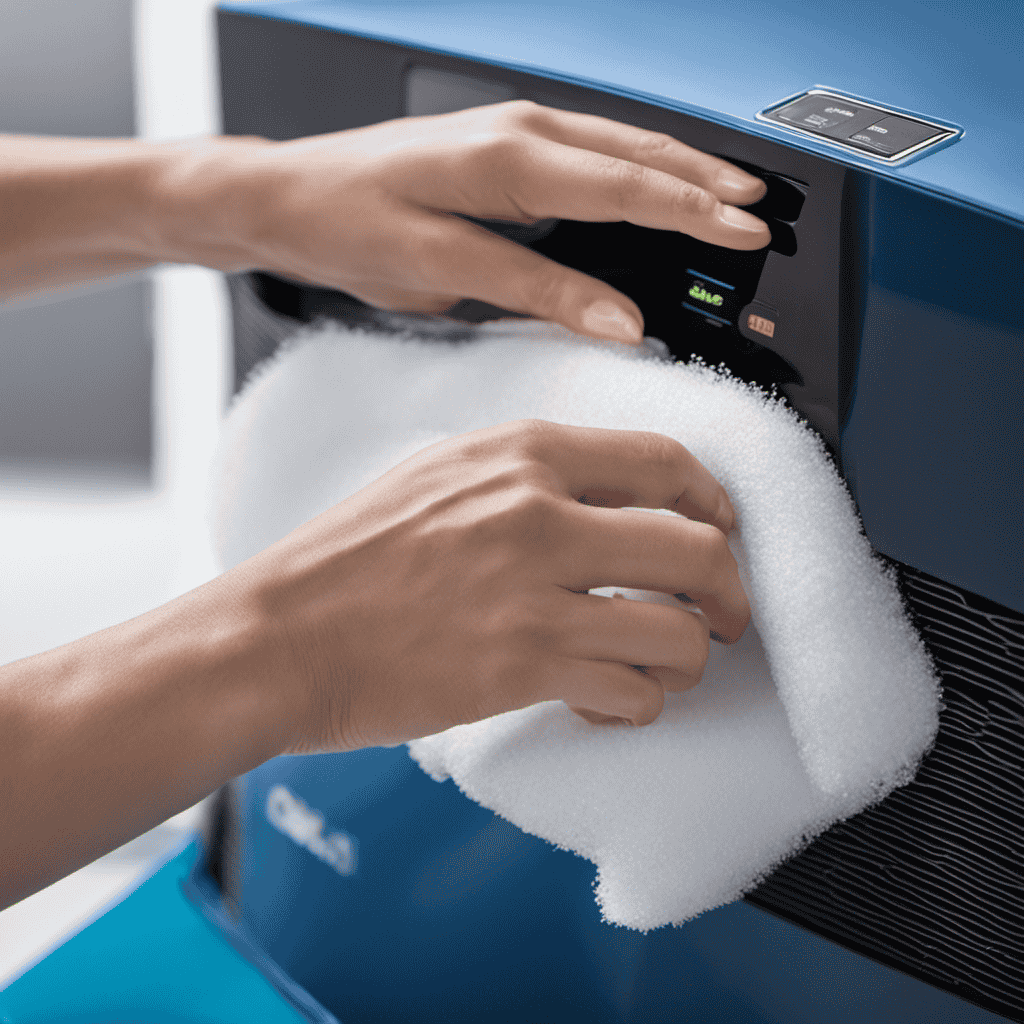When I enter a room, I am quickly greeted by a familiar scent. How does my air purifier detect odors?
In this article, we will delve into the fascinating world of odor sensing technology and uncover the role of sensors in detecting and analyzing odors.
By understanding the importance of odor detection for air quality, we can explore advanced techniques that enhance the efficiency of air purifiers.
Join me as we unravel the secrets behind how my air purifier senses odors.
Key Takeaways
- Odor sensing technology in air purifiers uses advanced sensors to analyze and identify odors in the air.
- Sensors must be highly sensitive, selective, and have a fast response time for real-time odor detection.
- Air purifiers use different detection methods such as chemical sensors, particulate sensors, electronic noses, and gas chromatography techniques.
- Air purifiers utilize sensor technology like metal-oxide sensors, optical sensors, and gas sensors to accurately detect and target unwanted odors.
Understanding the Odor Sensing Technology
You might be wondering how your air purifier senses odors. Well, it all comes down to the odor sensing technology that is incorporated into these devices.
The technology used in air purifiers is designed to analyze odors in the air and determine their source. This is done through the use of advanced sensors that are capable of detecting and measuring different chemical compounds present in odors.
These sensors are specifically designed to identify specific molecules that are associated with different types of odors. Once the sensors detect an odor, they send signals to the air purifier, which then activates its filtration system to remove the odor-causing particles from the air.
With this odor sensing technology, air purifiers are able to effectively eliminate unpleasant odors and improve the overall air quality in your home.
In the next section, we will discuss the role of sensors in detecting odors in more detail.
The Role of Sensors in Detecting Odors
To detect odors, sensors play a crucial role in identifying and capturing specific scents in the air. As an expert in the field of odor detection technology, I understand the importance of sensor accuracy in improving odor detection.
Here are four key factors that contribute to the accuracy of odor sensors:
-
Sensitivity: Odor sensors must be highly sensitive to detect even the faintest of smells in the air. This sensitivity allows for the detection of a wide range of odors, ensuring accurate results.
-
Selectivity: To accurately identify specific odors, sensors must have the ability to differentiate between different scent molecules. This selectivity ensures that only the target odors are detected, minimizing false positives.
-
Response time: The speed at which an odor sensor responds to a scent is crucial in real-time odor detection. A fast response time ensures immediate detection and allows for timely actions to be taken.
-
Stability: Odor sensors need to maintain consistent performance over time. Stability in sensor readings ensures reliable and accurate results, even after prolonged use.
How Air Purifiers Analyze and Identify Odors
When it comes to analyzing and identifying odors in the air, there are various methods and technologies that air purifiers use.
Odor detection methods can range from simple chemical sensors to more advanced techniques like gas chromatography.
Purifier sensor technology plays a crucial role in accurately detecting and measuring odors, allowing the device to effectively eliminate unwanted smells.
Odor Detection Methods
If you’re wondering how your air purifier senses odors, it typically uses different detection methods. Here are four common odor sensing techniques used by air purifiers:
-
Chemical Sensors: Air purifiers may utilize chemical sensors that can detect specific volatile organic compounds (VOCs) present in odors. These sensors work by reacting to the chemical composition of the odor molecules, triggering the purifier to eliminate them.
-
Particulate Sensors: Some air purifiers employ particulate sensors to detect fine particles that may carry odors. These sensors can identify the presence of smoke, dust, or other airborne particles associated with unpleasant smells.
-
Electronic Noses: Advanced air purifiers may incorporate electronic noses, which simulate the sense of smell through sensor arrays. These noses can analyze the odor profile and distinguish between different types of smells, enabling targeted odor elimination.
-
Gas Chromatography: Certain air purifiers utilize gas chromatography techniques to separate and analyze odor molecules. By identifying the specific compounds responsible for the odor, the purifier can effectively target and eliminate them.
Purifier Sensor Technology
Utilizing advanced sensor technology, air purifiers can accurately detect and eliminate a wide range of odors. These purifiers employ various sensing techniques to ensure sensor accuracy and efficient odor removal. One common technique is the use of chemical sensors, such as metal-oxide sensors, which work by detecting changes in electrical conductivity when exposed to certain odor molecules. Another technique is the utilization of optical sensors, which analyze the light absorption or scattering patterns produced by odor molecules. Additionally, some air purifiers incorporate gas sensors that measure the concentration of specific gases associated with odors. These sensing techniques enable the purifier to accurately identify and target unwanted odors, ensuring a fresh and clean indoor environment. The table below provides a visual representation of the purifier sensing techniques and their corresponding sensor accuracy.
| Sensing Technique | Sensor Accuracy |
|---|---|
| Chemical Sensors | High |
| Optical Sensors | Moderate |
| Gas Sensors | High |
Overall, the combination of these sensing techniques allows air purifiers to effectively detect and eliminate odors, providing improved indoor air quality.
Eliminating Unwanted Smells
To eliminate unwanted smells, you can adjust the settings on your air purifier to target specific odors. Here are four effective ways to remove unwanted smells with your air purifier:
-
Activated Carbon Filter: This filter is designed to trap and absorb odors, chemicals, and gases, effectively eliminating unpleasant smells from the air.
-
Ozone Generator: Some air purifiers have an ozone generator feature that releases ozone molecules into the air. Ozone is known to neutralize odors by breaking down the molecules that cause them.
-
Ionizer: An ionizer emits negatively charged ions into the air, which attach to positively charged particles like odors and allergens. This causes them to become heavier and fall to the ground, effectively removing the smells from the air.
-
Ultraviolet (UV) Light: Air purifiers equipped with UV light technology can target and eliminate odors caused by bacteria, viruses, and other microorganisms by disrupting their DNA and rendering them harmless.
By utilizing these features, you can effectively eliminate unwanted smells from your indoor environment, creating a fresh and pleasant atmosphere.
To ensure optimal air quality, it’s crucial to have an air purifier that can detect and eliminate odors.
The Importance of Odor Detection for Air Quality
Odor detection technology plays a crucial role in maintaining good air quality. By analyzing and identifying odors, we can better understand the sources of pollutants and take appropriate measures to improve the air we breathe.
This discussion will explore the impact of odor detection technology on air quality and how it can help us create healthier indoor and outdoor environments.
Odor Detection Technology
How does your air purifier detect smells?
-
Filter-based detection: Many air purifiers use filters to detect and eliminate odors. These filters are designed to trap and remove particles and pollutants from the air, including odor-causing molecules.
-
Activated carbon technology: Air purifiers often incorporate activated carbon filters, which are highly effective at adsorbing odors. The carbon material has a large surface area that can capture and trap odor molecules, preventing them from recirculating back into the air.
-
Chemical sensors: Some advanced air purifiers are equipped with chemical sensors that can detect specific odor molecules in the air. These sensors can identify the presence of odors and trigger the purifier to activate the appropriate odor elimination techniques.
-
Smart technology: With the advent of smart home devices, air purifiers can now be controlled and monitored remotely. Some air purifiers use smart technology to detect and analyze odors, adjusting their filtration systems accordingly for optimal odor elimination.
Understanding how air purifiers detect and eliminate odors is crucial for assessing their impact on air quality. By effectively sensing and eliminating odors, air purifiers can significantly improve the overall air quality in your home or office.
Impact on Air Quality?
After discussing odor detection technology in air purifiers, let’s now explore the impact of these devices on air quality and their ability to remove pollutants.
The presence of pollutants in the air can have detrimental effects on our health. Particles such as dust, pollen, pet dander, and volatile organic compounds (VOCs) can trigger allergies, respiratory issues, and even contribute to the development of chronic diseases.
Air purifiers equipped with odor detection technology play a crucial role in improving indoor air quality. By sensing and detecting odors, these devices can identify the presence of harmful substances and work towards removing them from the air.
Advanced filtration systems, such as HEPA filters, capture microscopic particles, while activated carbon filters effectively absorb and neutralize odors and VOCs. By removing these pollutants, air purifiers not only improve the quality of the air we breathe but also have a positive impact on our overall health and well-being.
Advanced Techniques for Odor Sensing in Air Purifiers
You’ll be amazed by the advanced techniques used in air purifiers to sense and eliminate unpleasant smells. These devices employ cutting-edge technology, including advanced algorithms and machine learning techniques, to detect and combat odors effectively.
Here are four remarkable features of air purifiers’ odor-sensing capabilities:
-
Chemical sensors: Air purifiers are equipped with specialized sensors that can identify specific molecules associated with different odors. These sensors detect volatile organic compounds (VOCs) present in the air and provide real-time data for effective odor elimination.
-
Pattern recognition: By using advanced algorithms and machine learning techniques, air purifiers can learn and recognize patterns in odor molecules. This allows them to differentiate between various smells and target specific compounds for removal.
-
Adaptive filtration: Air purifiers with odor-sensing capabilities can adjust their filtration settings based on the detected odors. They can activate additional filters or increase fan speed to efficiently capture and eliminate the offending smells.
-
Smart integration: Some air purifiers can connect to smart home systems or mobile apps, allowing users to monitor and control odor-sensing features remotely. This integration provides convenience and flexibility in managing indoor air quality.
With these advanced techniques, air purifiers can effectively sense and eliminate unpleasant odors, ensuring clean and fresh air in your home or workspace.
Enhancing Air Purifier Efficiency Through Odor Sensing
By employing advanced odor-sensing capabilities, air purifiers can significantly enhance their efficiency in eliminating unpleasant smells. Odor sensing technology allows air purifiers to detect and analyze the composition of indoor air, enabling them to target specific odorous compounds and effectively neutralize them.
This enhanced capability is achieved through the use of specialized sensors that can detect and quantify various volatile organic compounds (VOCs) present in the air. These sensors can identify the specific odors emitted by different sources, such as cooking, pets, or cleaning products, and adjust the air purification process accordingly.
Additionally, air purifier filters play a crucial role in improving indoor air quality by capturing and trapping airborne particles and allergens. The combination of odor-sensing technology and efficient air purifier filters ensures that not only are unpleasant smells eliminated, but also the overall air quality is significantly improved.
Frequently Asked Questions
Can an Air Purifier Completely Eliminate All Types of Odors?
An air purifier can be effective in removing stubborn odors, but its ability to completely eliminate all types of odors can be affected by factors such as the size and type of the air purifier, as well as the source and intensity of the odor.
How Long Does It Take for an Air Purifier to Sense and Detect an Odor?
How quickly can an air purifier detect odors? It depends on the specific model and its sensing technology. Air purifiers typically use sensors to detect odors, which can range from a few seconds to a few minutes.
Are There Any Specific Odors That Air Purifiers Have Difficulty Detecting?
I have found that air purifiers have varying degrees of sensitivity to specific odors. However, it is important to note that there are limitations to their odor detection capabilities, which can depend on factors such as the type and size of the purifier.
Can an Air Purifier Differentiate Between Different Types of Odors?
Well, let me tell you, air purifiers have this amazing ability to sense odors. They use filters to trap particles that cause odors, like pet smells. So yes, they can differentiate between different types of odors and remove them effectively.
Do Air Purifiers Emit Any Odors Themselves While Operating?
Air purifiers do not emit odors themselves while operating. They employ odor detection technology to sense odors in the air and use activated carbon filters to remove them, ensuring clean and fresh air.
Can a Dirty Air Purifier Affect its Ability to Sense Odors?
Regularly cleaning your clarifion air purifier is essential for maintaining its ability to sense odors. A dirty purifier can affect its functionality and compromise its odor-sensing capabilities. By keeping your air purifier clean, you can ensure that it continues to effectively eliminate unwanted odors in your space.
Conclusion
After delving into the intricate world of odor sensing technology in air purifiers, I’m astounded by the remarkable capabilities of these devices. Like a skilled detective, they meticulously analyze and identify odors, ensuring our air is pristine and fresh.
The importance of odor detection for air quality cannot be overstated. With advanced techniques constantly being developed, these purifiers are becoming even more efficient at enhancing our indoor environment.
So let’s embrace this olfactory revolution and breathe in the sweet scent of clean air.
